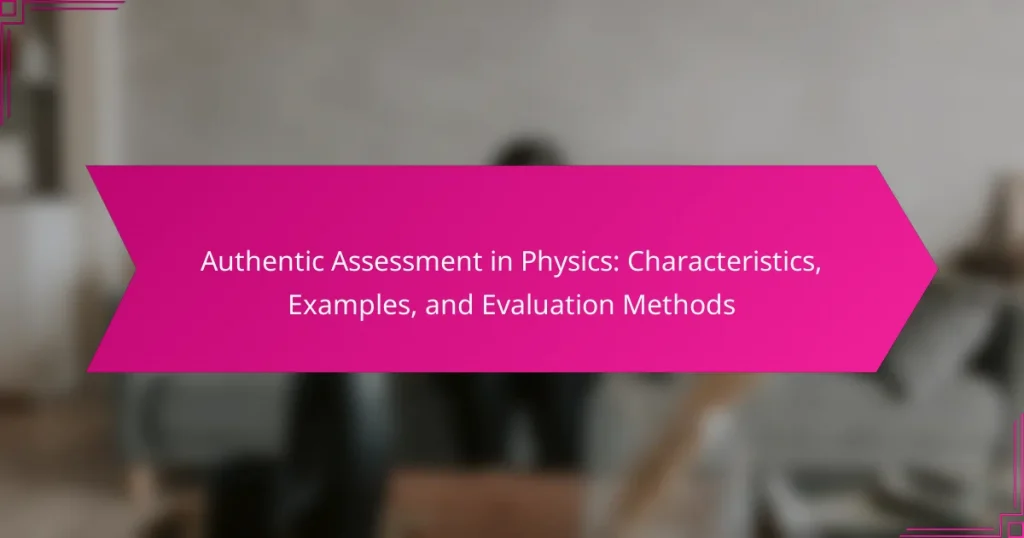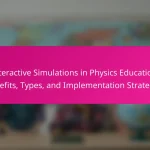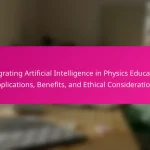Authentic assessment in physics is an evaluation method that measures students’ understanding of physics concepts through real-world tasks. This approach emphasizes the application of knowledge in practical situations, fostering critical thinking and problem-solving skills. Various types of authentic assessments include performance-based assessments, project-based assessments, and portfolio assessments, each designed to evaluate students’ abilities to apply their knowledge effectively. Key evaluation methods such as performance tasks, portfolios, observations, self-assessments, and peer assessments further enhance the learning experience by promoting engagement and collaboration. Research indicates that these assessment strategies significantly improve student learning outcomes in physics.
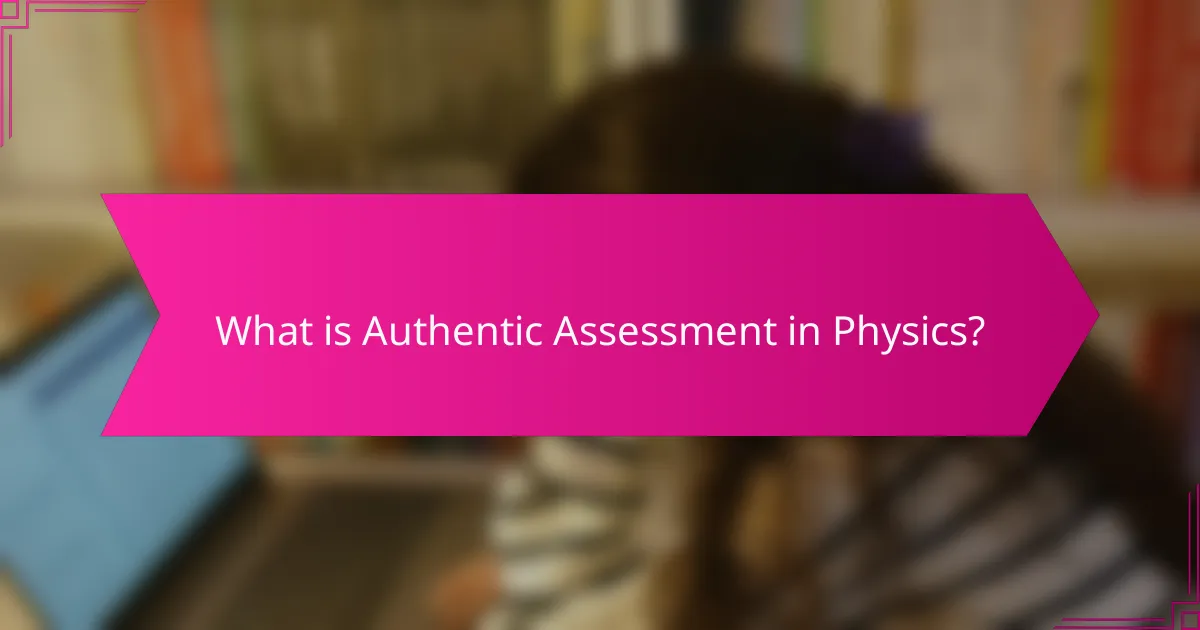
What is Authentic Assessment in Physics?
Authentic assessment in physics is an evaluation method that measures students’ understanding through real-world tasks. It focuses on applying physics concepts to practical situations. This approach encourages critical thinking and problem-solving. Authentic assessments may include experiments, projects, or simulations. They assess not only knowledge but also the ability to apply that knowledge. Research shows that authentic assessments can enhance student engagement and learning outcomes. For example, a study by Wiggins (1990) highlights how real-world tasks improve students’ application of physics principles.
How does Authentic Assessment differ from traditional assessment methods?
Authentic assessment differs from traditional assessment methods by emphasizing real-world tasks and applications. Traditional assessments often rely on standardized tests and quizzes that measure rote memorization. In contrast, authentic assessments require students to demonstrate their knowledge through practical, meaningful activities. For instance, students might conduct experiments or solve complex problems relevant to physics. Research shows that authentic assessments can enhance critical thinking and problem-solving skills. A study by Wiggins (1990) highlights that authentic assessments provide a more accurate reflection of student understanding and abilities.
What are the key characteristics of Authentic Assessment?
Authentic assessment is characterized by its focus on real-world tasks and applications. It emphasizes the application of knowledge and skills in practical contexts. This assessment type often involves projects, presentations, or performances that mirror real-life challenges. It promotes higher-order thinking and problem-solving abilities. Authentic assessments are typically criterion-referenced, allowing for clear standards of performance. They encourage self-reflection and peer assessment among students. Additionally, they provide meaningful feedback that informs future learning. Research shows that authentic assessments lead to deeper learning and increased student engagement.
Why is Authentic Assessment important in the field of Physics?
Authentic assessment is important in the field of Physics because it evaluates students’ understanding through real-world applications. This type of assessment measures not only knowledge but also the ability to apply concepts in practical scenarios. Research shows that authentic assessments improve student engagement and motivation. For example, a study by Wiggins (1990) highlights that students demonstrate deeper learning when assessed through tasks that mirror real-life challenges. Authentic assessments also encourage critical thinking and problem-solving skills essential for future scientific endeavors. They provide a more comprehensive picture of a student’s abilities compared to traditional testing methods.
What are the goals of Authentic Assessment in Physics?
The goals of Authentic Assessment in Physics include evaluating students’ understanding of physics concepts in real-world contexts. This approach aims to assess the application of knowledge rather than rote memorization. Authentic assessments encourage critical thinking and problem-solving skills. They also promote collaboration and communication among students. By using practical tasks, these assessments reflect the actual practices of physicists. The goal is to enhance student engagement and motivation in learning physics. Overall, Authentic Assessment seeks to provide a comprehensive evaluation of student learning outcomes.
How do these goals align with educational standards?
Authentic assessment goals align with educational standards by promoting critical thinking and real-world problem-solving. These assessments encourage students to apply physics concepts in practical situations. Educational standards emphasize the development of higher-order thinking skills. Authentic assessments provide opportunities for students to demonstrate their understanding through projects and presentations. Research shows that such methods enhance student engagement and learning outcomes. For instance, the Next Generation Science Standards advocate for hands-on, inquiry-based learning. This alignment ensures that assessments reflect what students need to know and be able to do in physics.
What skills does Authentic Assessment aim to develop in students?
Authentic Assessment aims to develop critical thinking, problem-solving, and self-assessment skills in students. It encourages students to apply knowledge in real-world contexts. This method emphasizes collaboration and communication among peers. Students learn to reflect on their learning processes. Authentic Assessment also fosters creativity and innovation in problem-solving. Research shows that these skills enhance student engagement and retention of knowledge. For instance, a study by Wiggins (1990) highlights the effectiveness of authentic tasks in promoting deeper understanding.
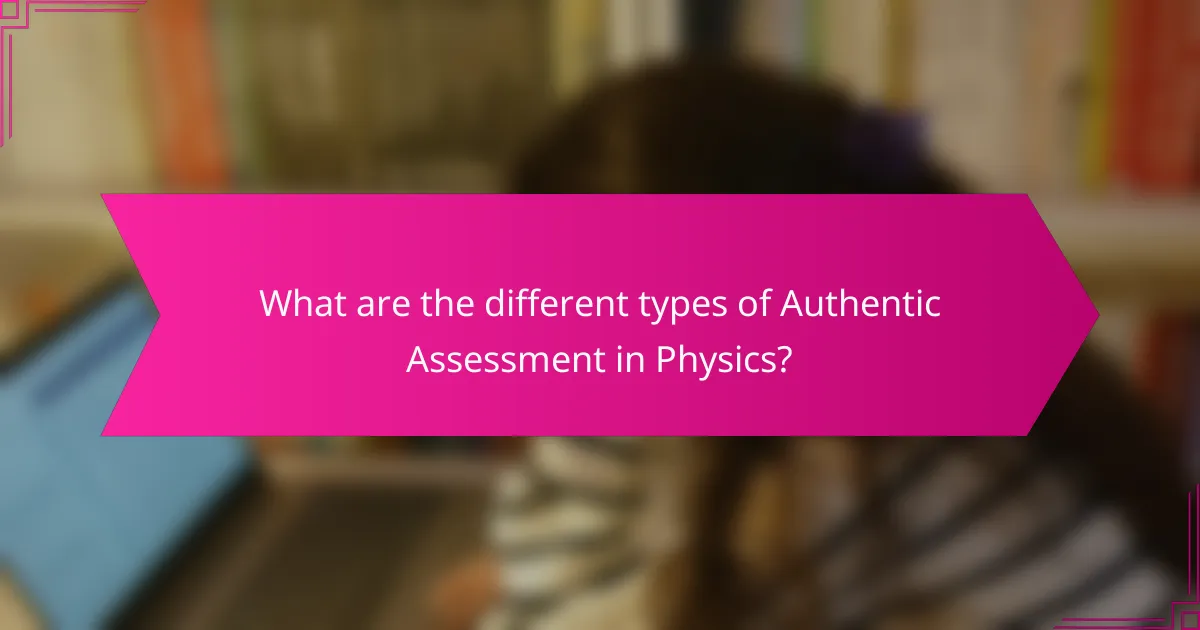
What are the different types of Authentic Assessment in Physics?
Different types of Authentic Assessment in Physics include performance-based assessments, project-based assessments, and portfolio assessments. Performance-based assessments require students to demonstrate their understanding through experiments or practical applications. Project-based assessments involve students working on real-world problems, often in collaborative settings. Portfolio assessments allow students to compile their work over time, showcasing their learning process and outcomes. Each type emphasizes critical thinking and application of knowledge in practical contexts.
What are some common examples of Authentic Assessment methods?
Common examples of Authentic Assessment methods include performance tasks, portfolios, and self-assessments. Performance tasks require students to apply their knowledge in real-world scenarios. Portfolios showcase a collection of student work over time, demonstrating learning progress. Self-assessments encourage students to reflect on their own learning and set personal goals. These methods provide a comprehensive evaluation of student understanding and skills. They align closely with educational standards and real-life applications, enhancing the relevance of assessments.
How are projects used as a form of Authentic Assessment?
Projects serve as a form of Authentic Assessment by allowing students to demonstrate their understanding of real-world applications of physics concepts. They engage students in hands-on activities that require critical thinking and problem-solving skills. Projects often involve collaboration, enabling peer interaction and feedback. This format mirrors professional practices in the field, making learning relevant and applicable. Research shows that project-based assessments can enhance retention of knowledge and skills. Studies indicate that students who participate in project-based learning outperform their peers in traditional assessments. Therefore, projects effectively assess students’ abilities in a meaningful context.
What role do portfolios play in assessing student learning?
Portfolios serve as a comprehensive tool for assessing student learning. They showcase a student’s work over time, highlighting their progress and understanding of concepts. Portfolios include various artifacts such as assignments, projects, and reflections. This diverse collection allows educators to evaluate both the process and the final product of learning. Research indicates that portfolios can improve student engagement and ownership of learning. A study by Barrett (2010) highlights that portfolios foster self-assessment and critical thinking skills. By reflecting on their work, students can identify strengths and areas for improvement. Overall, portfolios provide a multifaceted view of student learning and development.
How can performance tasks be effectively implemented in Physics?
Performance tasks can be effectively implemented in Physics by designing them to align with real-world applications. These tasks should engage students in hands-on experiments or projects that require critical thinking and problem-solving. For example, students can conduct experiments to demonstrate principles like Newton’s laws or energy conservation. Incorporating technology, such as simulations or data analysis software, enhances the learning experience. Assessment criteria should be clear, focusing on both the process and the final product. Providing timely feedback helps students reflect on their learning. Research shows that performance tasks improve student engagement and understanding of complex concepts in Physics.
What are the criteria for designing effective performance tasks?
Effective performance tasks must align with clear learning objectives. They should assess students’ ability to apply knowledge in real-world contexts. Tasks need to be authentic, meaning they reflect real-life challenges. Additionally, they should be challenging yet achievable to motivate learners. Performance tasks must include specific criteria for evaluation to ensure consistency. They should allow for student choice, enhancing engagement and ownership of learning. Finally, tasks should encourage collaboration and communication among students, fostering teamwork skills. These criteria ensure that performance tasks are meaningful and effective in assessing student learning.
How do performance tasks evaluate student understanding?
Performance tasks evaluate student understanding by requiring students to apply their knowledge and skills in real-world scenarios. These tasks assess not only factual knowledge but also critical thinking and problem-solving abilities. Students demonstrate their understanding through hands-on activities, projects, or presentations. For example, in physics, a performance task might involve conducting an experiment and analyzing the results. Research shows that performance tasks provide a comprehensive measure of student learning. They often reveal deeper insights into student comprehension compared to traditional testing methods. Studies indicate that students engaged in performance tasks tend to retain information better and develop a more profound understanding of concepts.
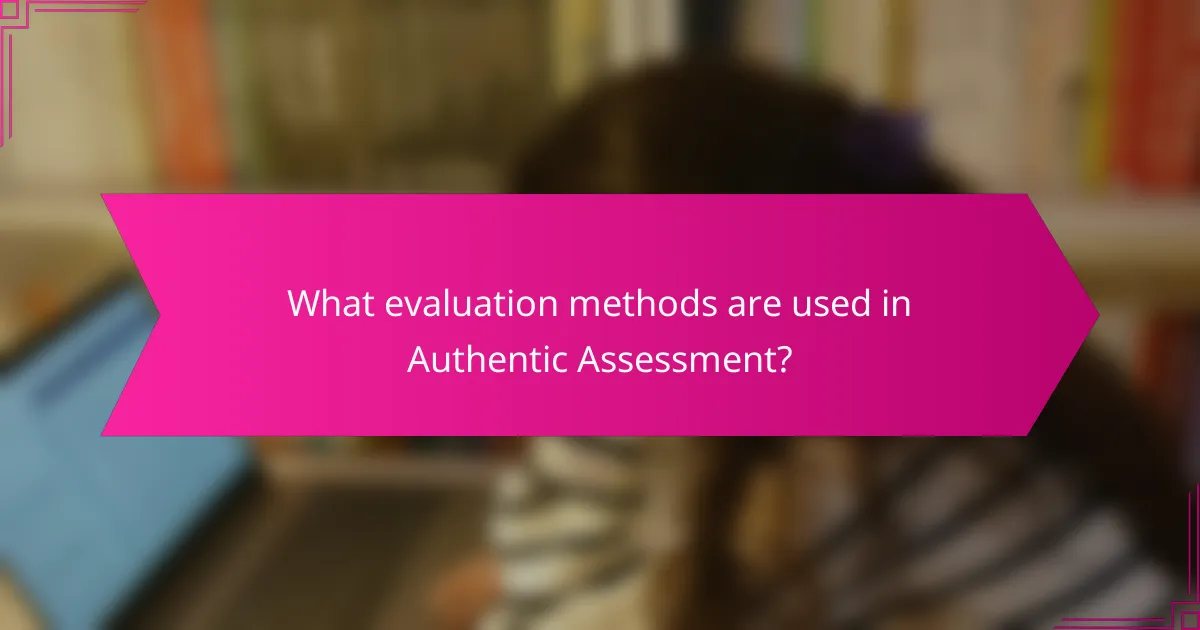
What evaluation methods are used in Authentic Assessment?
Authentic assessment utilizes various evaluation methods to measure student learning. Key methods include performance tasks, where students demonstrate knowledge through real-world applications. Portfolios are also common, allowing students to compile and reflect on their work over time. Observations provide insights into student engagement and process, while self-assessments encourage reflection on personal learning. Peer assessments foster collaborative learning by allowing students to evaluate each other’s work. These methods align with the principles of authentic assessment, emphasizing practical skills and real-life relevance in educational contexts.
How is student performance evaluated in Authentic Assessment?
Student performance in Authentic Assessment is evaluated through real-world tasks and projects. These tasks require students to apply their knowledge and skills in practical scenarios. Evaluation focuses on both the process and the final product. Rubrics are often used to assess various aspects, such as creativity, critical thinking, and collaboration. Feedback is continuous, allowing for reflection and improvement. This approach aligns with educational standards and learning objectives. Research shows that Authentic Assessment enhances student engagement and retention of knowledge.
What tools and rubrics are commonly used for evaluation?
Common tools and rubrics used for evaluation include performance assessments, portfolios, and observational checklists. Performance assessments measure students’ ability to apply knowledge in real-world tasks. Portfolios showcase a collection of student work over time, demonstrating progress and learning. Observational checklists provide a structured way to assess student behaviors and skills during activities. Rubrics, which outline criteria for grading, help ensure consistency and transparency in evaluation. These tools promote a comprehensive understanding of student learning in physics.
How do peer assessments contribute to the evaluation process?
Peer assessments enhance the evaluation process by providing diverse perspectives on student performance. They encourage critical thinking and self-reflection among peers. This method allows students to engage with evaluation criteria actively. Research indicates that peer feedback can improve learning outcomes by as much as 25%. Furthermore, peer assessments foster collaborative learning environments. They help students develop communication skills and deepen their understanding of the subject matter. The inclusion of peer evaluations adds a layer of accountability in group settings. Overall, peer assessments contribute significantly to a more comprehensive evaluation process.
What challenges are faced in implementing Authentic Assessment in Physics?
Implementing Authentic Assessment in Physics faces several challenges. One significant challenge is the alignment of assessments with curricular goals. Many traditional assessments focus on rote memorization rather than practical application. Another challenge is the need for teacher training in authentic assessment methods. Educators may lack experience in designing assessments that reflect real-world physics applications. Time constraints also pose a problem. Developing and implementing authentic assessments requires more time than traditional testing methods. Additionally, resource availability can limit the effectiveness of these assessments. Schools may not have the necessary materials or technology for hands-on activities. Finally, ensuring consistency and fairness in grading can be difficult. Authentic assessments often involve subjective evaluation, which can lead to discrepancies in grading. These challenges hinder the widespread adoption of authentic assessment in Physics education.
How can educators overcome these challenges?
Educators can overcome challenges in authentic assessment by implementing targeted strategies. First, they can provide professional development focused on assessment techniques. This training helps educators understand and apply authentic assessment methods effectively. Second, collaboration among educators can enhance resource sharing and support. By working together, teachers can develop assessments that reflect real-world applications. Third, integrating technology can streamline assessment processes. Tools like online platforms facilitate feedback and data collection. Lastly, involving students in the assessment process encourages ownership and engagement. Research shows that student involvement leads to deeper learning outcomes. These strategies create a supportive environment for implementing authentic assessments in physics education.
What best practices should educators follow for effective Authentic Assessment?
Educators should implement several best practices for effective Authentic Assessment. First, they must align assessments with real-world tasks. This connection enhances relevance and application for students. Second, they should involve students in self-assessment and reflection. Research shows this promotes deeper understanding and ownership of learning. Third, educators need to provide clear criteria and rubrics. This transparency helps students understand expectations and improves performance. Fourth, diverse assessment methods should be utilized. Incorporating projects, presentations, and portfolios caters to different learning styles. Fifth, timely feedback is essential. Studies indicate that prompt feedback significantly enhances student learning outcomes. Lastly, educators should foster a collaborative environment. Group assessments encourage teamwork and communication skills. These best practices collectively enhance the effectiveness of Authentic Assessment in educational settings.
Authentic Assessment in Physics is an evaluation method that measures students’ understanding through real-world tasks, focusing on the application of physics concepts in practical situations. This article outlines the characteristics of authentic assessment, including its emphasis on critical thinking and problem-solving, and compares it to traditional assessment methods that often rely on rote memorization. It explores various types of authentic assessments, such as performance-based, project-based, and portfolio assessments, and discusses the evaluation methods used to assess student performance, including rubrics and peer assessments. Additionally, the article addresses the challenges educators face in implementing authentic assessment and offers best practices for effective execution in physics education.
